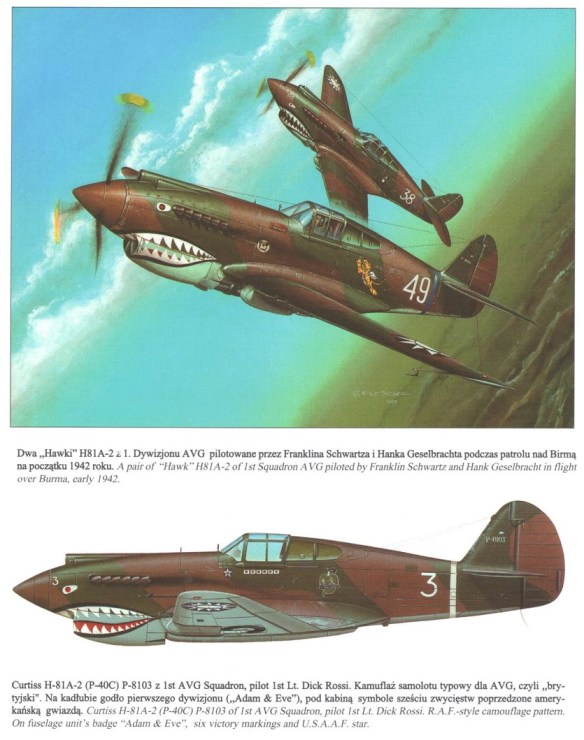
The Curtiss P-40 Warhawk was an American single-engine, single-seat, all-metal fighter and ground attack aircraft that first flew in 1938. The P-40 design was a modification of the previous Curtiss P-36 Hawk which reduced development time and enabled a rapid entry into production and operational service. The Warhawk was used by the air forces of 28 nations, including those of most Allied powers during World War II, and remained in front line service until the end of the war. It was the third most-produced American fighter, after the P-51 and P-47; by November 1944, when production of the P-40 ceased, 13,738 had been built, all at Curtiss-Wright Corporation’s main production facilities at Buffalo, New York.
Warhawk was the name the United States Army Air Corps adopted for all models, making it the official name in the United States for all P-40s. The British Commonwealth and Soviet air forces used the name Tomahawk for models equivalent to the P-40B and P-40C, and the name Kittyhawk for models equivalent to the P-40D and all later variants.
P-40s first saw combat with the British Commonwealth squadrons of the Desert Air Force (DAF) in the Middle East and North African campaigns, during June 1941. The Royal Air Force’s No. 112 Squadron was among the first to operate Tomahawks, in North Africa, and the unit was the first Allied military aviation unit to feature the “shark mouth” logo, copying similar markings on some Luftwaffe Messerschmitt Bf 110 twin-engine fighters.
The P-40’s lack of a two-stage supercharger made it inferior to Luftwaffe fighters such as the Messerschmitt Bf 109 or the Focke-Wulf Fw 190 in high-altitude combat and it was rarely used in operations in Northwest Europe. Between 1941 and 1944, however, the P-40 played a critical role with Allied air forces in three major theaters: North Africa, the Southwest Pacific and China. It also had a significant role in the Middle East, Southeast Asia, Eastern Europe, Alaska and Italy. The P-40’s performance at high altitudes was not as critical in those theaters, where it served as an air superiority fighter, bomber escort and fighter bomber. Although it gained a post-war reputation as a mediocre design, suitable only for close air support, more recent research including scrutiny of the records of individual Allied squadrons indicates that the P-40 performed surprisingly well as an air superiority fighter, at times suffering severe losses, but also taking a very heavy toll on enemy aircraft. The P-40 offered the additional advantage of low cost, which kept it in production as a ground-attack fighter long after it was obsolete in the air superiority role.
The 325th FG (known as the “Checkertail Clan”) flew P-40s in the MTO. The 325th was credited with at least 133 air-to-air kills in April–October 1943, of which 95 were Bf 109s and 26 were Macchi C.202s, for the loss of 17 P-40s in combat. An anecdote concerning the 325th FG, indicates what could happen if Bf 109 pilots made the mistake of trying to out-turn the P-40. 325th FG historian Carol Cathcart wrote: “on 30 July, 20 P-40s of the 317th [Fighter Squadron] … took off on a fighter sweep … over Sardinia. As they turned to fly south over the west part of the island, they were attacked near Sassari… The attacking force consisted of 25 to 30 Bf 109s and Macchi C.202s… In the brief, intense battle that occurred … [the 317th claimed] 21 enemy aircraft.” Cathcart states that Lt. Robert Sederberg who assisted a comrade being attacked by five Bf 109s, destroyed at least one German aircraft, and may have shot down as many as five. Sederberg was shot down in the dogfight and became a prisoner of war.
A famous African American unit, the 99th FS, better known as the “Tuskegee Airmen” or “Redtails”, flew P-40s in stateside training and for their initial eight months in the MTO. On 9 June 1943, they became the first African American fighter pilots to engage enemy aircraft, over Pantelleria, Italy. A single Focke Wulf Fw 190 was reported damaged by Lieutenant Willie Ashley Jr. On 2 July the squadron claimed its first verified kill; a Fw 190 destroyed by Captain Charles Hall. The 99th would continue to score with P-40s until February 1944, when they were assigned P-39s.
The much-lightened P-40L was most heavily used in the MTO, primarily by U.S. pilots. Many US pilots stripped down their P-40s even further to improve performance, often removing two or more of the wing guns from the P-40F/L.